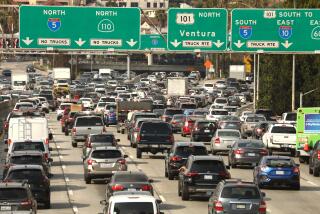Car Fumes Linked to High Medical Costs : Health: A study says the nation pays $50 billion a year for emissions-caused illnesses. It calls for strict new pollution controls.
- Share via
WASHINGTON — Air pollution from motor vehicles is responsible for $40 billion to $50 billion in annual health care expenditures and as many as 120,000 unnecessary or premature deaths, according to a series of studies released Friday by the American Lung Assn.
“Five years ago, $40 billion was considered the high range,” said James S. Cannon, an environmental analyst and one of the study authors.
“Now, what used to be considered the high-range costs are now the mid-range costs,” Cannon said. “In the past, we’ve understated, underestimated and under-recognized the costs of living in a polluted environment.”
The association said that the estimated annual health care costs associated with motor vehicle pollution extend from as little as $4 billion to as much as $93 billion, but it appears that $40 billion to $50 billion is the most realistic range.
The authors, asserting that new controls on auto pollution are “feasible, cost-effective and necessary” to reduce the health consequences of air pollution, called for passage of clean air legislation expected to be taken up by the Senate when it returns to work next week.
The Senate’s anti-pollution package is considerably tougher than a clean air initiative introduced last summer by the Bush Administration. The President has threatened to veto the Senate bill if it fails to balance environmental protection with economic growth.
Release of the reports by the lung association represents an attempt to identify the costs associated with leaving the nation’s clean air standards unchanged.
“The health and environmental need for more stringent vehicle controls can no longer be debated,” said Michael P. Walsh, a former Environmental Protection Agency official who worked in the area of motor vehicle pollution control.
“Substantial additional control of motor vehicles will be required to achieve the air quality objectives which are necessary to protect public health and the environment.”
On Thursday, the Business Roundtable, which represents the nation’s largest corporations, released a study saying that the Senate’s clean air legislation would cost as much as $104 billion a year to implement.
The Business Roundtable estimates, which do not mention the health care costs addressed by the American Lung Assn., included $25 billion to control toxic air emissions, $24 billion for urban smog and $5 billion for acid rain.
The Business Roundtable study said California would bear the largest cost, at $11 billion a year, followed by Texas, $10.4 billion; Louisiana, $2.7 billion; Illinois, $2.6 billion; New York, $2.1 billion, and Tennessee, $2 billion.
The American Lung Assn. estimated that the auto standards mandated in the Senate legislation for the year 2003 would reduce national emissions of smog-forming pollutants by more than 450,000 tons, at a cost of about $2,000 a ton.
Further, the group said, the standards would result in a reduction of nearly 14 million tons of carbon monoxide, at a cost of less than $250 a ton.
The association noted that the provisions in the Senate bill “fall well short of the ambitious standards under consideration in California.”
One of the studies released by the American Lung Assn., conducted by UC Davis, estimated that between 50,000 and 120,000 deaths each year could be linked to the health effects of auto pollution.
Walsh said that another study, funded by UC Fullerton, estimated that annual health care savings in California could be increased from an expected $9.4 billion under current federal standards to $14.3 billion if California’s proposed tougher standards are adopted.
Cannon said he surveyed five years’ worth of studies that attempted to express in dollars the extent of illness and premature death resulting from air pollution and concluded that “the price tag of pollution is rising.”
“In studies where direct comparison of the various economic effects was possible,” he said, “health costs appeared as the most significant or among the most significant of the adverse economic repercussions of air pollution.”
More to Read
Sign up for Essential California
The most important California stories and recommendations in your inbox every morning.
You may occasionally receive promotional content from the Los Angeles Times.













